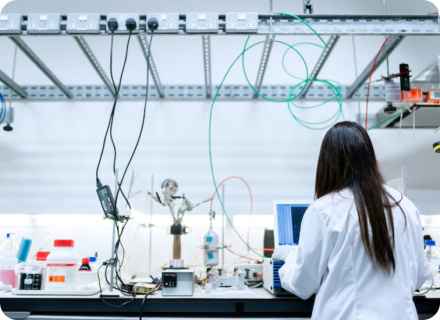Pandemic 2.0 – Where Do We Go From Here? The Delta Variant and the Young.
With the Delta variant becoming dominant globally, we need to change how we think about the properties and destructive potential of new virus variants. We need good policy decisions to ensure sufficient protection of our unprotected young, for health and for the economy.
Throughout the pandemic, the daily number of infections, hospitalizations, and deaths from the coronavirus have been used by decision-makers to assess the purported risk related to the pandemic. However, with larger parts of the world vaccinated, these parameters increasingly give an insufficient picture of the public health risks, especially for the unvaccinated. And, the majority of the unvaccinated are young.
Increasing evidence shows that the Delta variant, already known to be extremely contagious, is among the most transmissible viruses we know about. With increased transmissibility comes the need for an even higher proportion of the population to be immune to slow the spread of the virus. In this situation, sufficient non-pharmacological interventions to control the pandemic are needed, otherwise most unvaccinated individuals will encounter the virus within a fairly short time. With schools starting soon, transmission among the young is likely to increase dramatically.
How will this affect children and young people? Despite an abundance of research based on earlier variants, with Delta, we still have little certainty of what lies ahead. Much of what we know to date pertains to earlier virus variants with differing levels of transmissibility, disease severity, risk factors, and vaccine efficacy.
Troubling reports are emerging from multiple countries facing Delta variant surges of children requiring hospital treatment or dying from COVID. There is evidence that this may be not only due to the rapid increase in cases, but also because the Delta variant may cause more serious disease. Regardless, it seems clear that children and young adults now face a greater threat from SARS-CoV-2 than at any previous point in the pandemic.
For the young, a rapidly growing body of evidence illustrates the risk of long-term complications, including organ damage. A small number of children with COVID-19 are affected by Multisystem Inflammatory Syndrome (MIS-C), which commonly leads to cardiac dysfunction, myocarditis, coronary artery dilation, and aneurysms. With larger infection numbers, we will likely see many more of these cases.
SARS-CoV-2 is not just a respiratory virus, and it has been suggested that the coronavirus itself enters the brain via the olfactory route. In one recent preprint, a large controlled study of brain scans demonstrated loss of grey matter in certain parts of the brain following COVID-19, especially in areas regulating smell. Loss of brain tissue was also found in people with mild disease; for those with more severe disease, tissue loss occurred also in memory-related parts of the brain. In a recent study on adults, reduced memory was reported by 12 percent of participants eight months post-COVID. Cognitive deficits have been reported in a study of 90,000 people after COVID-19 infection. An international consortium to study the short-and long-term consequences of SARS-CoV-2 on the central nervous system, supported by the WHO, is now also investigating whether COVID-19 may increase the risk of developing dementia in the longer term.
It is still not known how the results from these studies relate to children and young people. However, examining children hospitalised with COVID-19 prior to Delta, the occurrence of neurological or psychiatric effects from COVID-19 was shown to be four times more common for children and adolescents compared to adults. And, in a recent study published in Nature, 13 percent of home-isolated young adults, aged 16–30 years reported reduced concentration at six months, 11 percent had memory problems, and more than half still experienced one or more symptoms at six months. Such symptoms are commonly reported in those suffering from Long COVID and may have a deleterious impact on education, cognitive and social development, in spite of not being reflected in the number of hospitalizations and deaths. These are problems that can still lead to considerable human, societal and economic cost in the short, medium, and long term.
In this scenario of high risk and uncertainty, and with prevention soon available, mass infection of the young is not an ethically defensible option.
Countries should combine vaccination campaigns with non-pharmaceutical interventions to eliminate SARS-CoV-2 transmission. Where it is safe for schools to be open, ventilation should be a priority, and authorities should strive to make resources available for the children to be taught in smaller cohorts and ensure physical distancing. Masking should be in place wherever possible as universal protection. Parents should get vaccinated, to protect themselves and their children.
Within a few months, results from clinical trials in children down to six months will be available. For now, health authorities should take steps to vaccinate children starting at age twelve, when vaccine availability allows. Since school starts soon, time is of the essence.
Minimizing the number of infections is the best strategy for preventing the emergence of new, more dangerous variants. Every case of infection can be equated to buying another ticket to the variant lottery. Every country that decides to reduce the control of the virus, adds not only to their own risk, but to the risk of the whole world. In solidarity with the world, we must control the spread of the SARS-CoV-2 virus.
Authors
Gunhild Nyborg, M.D., PhD., Covid Action Group, World Health Network, Norway.
Andrew Ewing, Professor of Chemistry and Molecular Biology, University of Gothenburg; Member of the Swedish Academy of Science, Sweden.
Yaneer Bar-Yam, President, New England Complex Systems Institute, Covid Action Group, World Health Network, USA.
Cécile Philippe, Economist, President of the Institut économique Molinari, France.
Matthias F. Schneider, Professor of Physics, University of Dortmund, Covid Action Group, World Health Network, Germany.
Shu-Ti Chiou, President, Health & Sustainable Development Foundation, Covid Action Group, World Health Network, Taiwan.
Sunil Raina, Physician Researcher, Head, Community Medicine, Dr. RP Govt. Medical College, HP, Covid Action Group, World Health Network, India.
Bengt Norden, Professor of Physical Chemistry, Chalmers University of Technology, Member of the Swedish Academy of Science, Sweden.
Sigurd Bergmann, Professor of Philosophy and Religious Studies, Norwegian University of Science and Technology, Professor of Theology, Uppsala University, Sweden.
Published In


